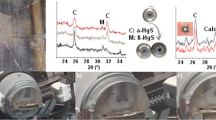Abstract
The red mineral pigment known as cinnabar (HgS) was commonly employed in Roman fresco wall paintings. Fresco artists of the period favored this pigment for its striking red color. However, upon excavation and exposure to air and light, cinnabar-pigmented surfaces recovered from archaeological contexts often proved to be unstable. Mural paintings colored with cinnabar that have been exposed in the open air frequently demonstrate a disfiguring, irreversible darkening of the surface. Traditionally, scholars have attributed this alteration to a light-induced phase change from red α-cinnabar to black β-cinnabar (meta-cinnabar). While this transformation has not been totally excluded, the prevailing view among conservation scientists is that chlorine plays a key role in the darkening process through the formation of light-sensitive mercury chloride compounds, or as a catalyst in the photochemical redox of Hg(II)S into Hg(0) and S(0). Using laboratory-based experiments and thermodynamic modeling, this paper attempts to further clarify the mechanism(s) and kinetics of cinnabar alteration in fresco applications, especially the role of light, humidity, and chlorine ions. Additionally, it explores possible pathways and preventive as well as remedial conservation treatments during or immediately following excavation, to inhibit or retard darkening of cinnabar-pigmented fresco surfaces.
















Similar content being viewed by others
Notes
The presence of zinc or iron has been shown to reduce the temperature of transformation, to 204 and 305 °C, respectively. While substantially lower, the temperature required to induce this phase change still remains quite high.
While chlorine has been the most thoroughly explored, other halogens, namely iodine, have also been shown to trigger the blackening of cinnabar.
References
P.W. Lehmann, Roman Wall Paintings from Boscoreale in the Metropolitan Museum of Art (Archaeological Institute of America, Cambridge, 1953)
J.R. Clarke, The Houses of Roman Italy, 100 B.C.-A.D. 250: Ritual, Space, and Decoration (University of California Press, Berkeley, 1991)
M. Bussagli, Rome, Art and Architecture (Könemann, Cologne, 1999)
A. Maiuri, Roman Painting. Trans. Stuart Gilbert (Skira, Geneva, Switzerland, 1953)
R. Ling, Roman Painting (Cambridge University Press, Cambridge, 1991)
E.M. Moormann, in Functional and Spatial Analysis of Wall Painting. Proceedings of the 5th International Congress on Ancient Wall Painting, Amsterdam, 8–12 September 1992 (Stichting Babesch, Leiden, 1993)
P. Mora, L. Mora, P. Philippot, The Conservation of Wall Paintings (Butterworth & Co., New York, 1984)
C. Arendt, in The Role of Architectural Fabric in the Preservation of Wall Paintings, ed. by S. Cather. The Conservation of Wall Paintings: Proceedings of a Symposium Organized by the Courtauld Institute of Art and the Getty Conservation Institute, London, July 13–16, 1987 (Getty Conservation Institute, Marina del Rey, CA, 1991)
A. Arnold, K. Zehnder, in Monitoring Wall Paintings Affected by Soluble Salts, ed. by S. Cather. The Conservation of Wall Paintings: Proceedings of a Symposium Organized by the Courtauld Institute of Art and the Getty Conservation Institute, London, July 13–16, 1987 (Getty Conservation Institute, Marina del Rey, CA, 1991)
M. Matteini, in Review: An Assessment of Florentine Methods of Wall Painting Conservation Based on the Use of Mineral Treatments. ed. by S. Cather, The Conservation of Wall Paintings: Proceedings of a Symposium Organized by the Courtauld Institute of Art and the Getty Conservation Institute, London, July 13–16, 1987 (Getty Conservation Institute, Marina del Rey, CA, 1991)
O. Ciferri, P. Tiano, G. Mastromei, Of Microbes and Art: The Role of Microbial Communities in the Degradation and Protection of Cultural Heritage (Kluwer Academic/Plenum Publishers, New York, 2000)
L. Dei, A. Ahle, P. Baglioni, D. Dini, E. Ferroni, Green degradation products of azurite in wall paintings: identification and conservation treatment. Stud. Conserv. 43, 80–88 (1998)
S. Giovannoni, M. Matteini, A. Moles, Studies and developments concerning the problem of altered lead pigments in wall painting. Stud. Conserv. 35, 33–51 (1990)
V. Daniels, R. Stacey, A. Middleton, The blackening of paint containing egyptian blue. Stud. Conserv. 49, 217–230 (2004)
E. Minopoulou, A study of smalt and red lead discolouration in antiphonitis wall paintings in cyprus. Appl. Phys. Mater. Sci. Process. 96, 701–711 (2009)
Pliny, The Elder Pliny’s Chapters on Chemical Subjects, ed. by K.C. Bailey (E. Arnold & Co., London, UK, 1929)
Vitruvius, The Ten Books on Architecture. Tran. H. M. Morgan (Dover Publications, New York, 1960)
R.J. Gettens, R.L. Feller, W.T. Chase, in ‘Vermillion and Cinnabar’, In Artists’ Pigments a Handbook of Their History and Characteristics. ed. by R.L. Feller, A. Roy, E. West FitzHugh, B. Hepburn Berrie (National Gallery of Art, Washington, 1986)
M. Cotte, J. Susini, N. Metrich, A. Moscato, C. Gratziu, A. Bertagnini, M. Pagano, Blackening of Pompeian cinnabar paintings: X-ray microspectroscopy analysis. Anal. Chem. 78, 7484–7492 (2006)
R.L. Feller, Studies on the Darkening of Vermilion by Light. Report and Studies in the History of Art (National Gallery of Art, Washington, DC, 1967)
R.J. Gettens, R.L. Feller, W.T. Chase, Vermilion and cinnabar. Stud. Conserv. 17, 45–69 (1972)
V. Daniels, R. Stacey, A. Middleton, in ‘The Blackening of Vermillion by Light’, In Recent Advances in Conservation and Analysis of Artifacts. ed. by J. Black (Summer School Press, London, UK, 1987)
M. Spring, R. Grout, The blackening of vermilion: an analytical study of the process in paintings. Natl. Gallery Tech. Bull. 23, 50–61 (2002)
R. Grout, A. Burnstock, A study of the blackening of vermilion. Zeitschrift für Kunsttechnologie und Konservierung 141, 15–22 (2000)
I. Istudor, A. Dina, G. Rosu, D. Seclaman, G. Niculescu, An alteration phenomenon of cinnabar red pigment in mural paintings from sucevita. E_Conservation 2, 24–33 (2007)
F.W. Dickson, G. Tunell, The stability of cinnabar and metacinnabar. Am. Minerol. 44, 471–487 (1959)
J.K. McCormack, The darkening of cinnabar in sunlight. Miner. Deposita 35, 796–798 (2000)
J.K. McCormack, Mercury Sulf-Halide Minerals and Crystalline Phases, and Experimental Formation Conditions, in the System Hg 3 S 2 Cl 2 –Hg 3 S 2 Br 2 –Hg 3 S 2 I 2 (Thesis (Ph. D.)-University of Nevada, Reno, 1997)
M. Radepont, Understanding of Chemical Reactions Involved in Pigment Discoloration, in Particular in Mercury Sulfide (HgS) Blackening (PhD thesis, Universiteit Antwerpen, 2013)
F. Da Pieve, C. Hogan, D. Lamoen, J. Verbeeck, F. Vanmeert, M. Radepont, M. Cotte, K. Janssens, X. Gonze, G. Van Tendeloo, Casting light on the darkening of colors in historical paintings. Phys. Rev. Lett. 111 (2013). doi:10.1103/PhysRevLett.111.208302
H. Béarat, Chemical and mineralogical analyses of Gallo-Roman wall painting from Dietikon, Switzerland. Archaeometry 38, 81–95 (1996)
J.K. McCormack, F.W. Dickson, M.P. Leshendok, Radtkeite, Hg 3 S 2 ClI, a new mineral from the McDermitt mercury deposit, Humboldt County, Nevada. Am. Mineral. 76, 1715–1721 (1991)
R.S. Davidson, C.J., Willsher C.J., The Light-induced Blackening of Red Mercury (II) Sulphide. Journal of the Chemical Society 1981, Dalton Transactions 3, 833-835
K. Keune, J.J. Boon, Analytical imaging studies clarifying the process of the darkening of vermilion in paintings. Anal. Chem. 77, 4742–4750 (2005)
M. Cotte, J. Susini, J. Dik, K. Janssens, Synchrotron-based X-ray absorption spectroscopy for art conservation: looking back and looking forward. Acc. Chem. Res. 46, 705–714 (2010)
M. Radepont, W. de Nolf, K. Janssens, G. Van der Snickt, Y. Coquinot, L. Klaassen, M. Cotte, The use of microscopic X-ray diffraction for the study of HgS and its degradation products corderoite, kenhsuite and calomel in historical paintings. J. Anal. At. Spectrom. 26, 959–968 (2011)
M. Radepont, Y. Coquinot, K. Janssens, J. Ezrati, W. de Nolf, M. Cotte, Thermodynamic and experimental study of the degradation of the red pigment mercury sulfide. J. Anal. At. Spectrom. 30, 599–612 (2015)
M. Cotte, J. Susini, V.A. Solé, Y. Taniguchi, J. Chillida, E. Checroun, P. Walter, Applications of synchrotron-based micro-imaging techniques to the chemical analysis of ancient paintings. J. Anal. At. Spectrom. 23, 820–828 (2008)
W. Anaf, K. Janssens, K. De Wael, Formation of metallic mercury during photodegradation/photodarkening of a-HgS: electrochemical evidence. Angew. Chem. 125, 12800–12803 (2013)
K.L. Gauri, A.N. Chowdhury, N.P. Kulshreshtha, A.R. Punuru, The sulfation of marble and the treatment of gypsum crusts. Stud. Conserv. 34, 201–206 (1989)
P. Ausset, R. Lefevre, J. Philippon, C. Venet, in Large-Scale Distribution of Fly-Ash Particles Inside Weathering Crusts on Calcium Carbonate Substrates: Some Examples on French Monuments, ed. by D. Decrouez, J. Chamay, F. Zezza. La Conservation des Monuments dans le Basin Méditerranéen: Actes du 2ème Symposium International = The Conservation of Monuments in the Mediterranean Basin: Proceedings of the 2nd International Symposium (Ville de Geneve, Museum d’histoire naturelle, and Muse d’art et d’histoire., Geneva, 1992), pp. 121–139
V. Fassina, in Atmospheric Pollutants Responsible for Stone Decay: Wet and Dry Surface Deposition of Air Pollutants on Stone and the Formation of Black Scabs, ed. by F. Zezza. Weathering and Air Pollution: Primo Corso Della Scuola Universitaria C.U.M. Conservazione dei Monumenti, Lago di Garda (Portese), Venezia, Milano, 2–9 Settembre 1991 (Mario Adda Editore, Bari, 1992), pp. 67–86
M. Tennikat, Blumenkohl-, Sinter-und Seidenglanzkruste: Salzkartierung und naturwissenschaftliche Erklärungen. Forschungsprojekt Wandmalerei-Schäden: ein Förderprojekt des Bundesministers für Forschung und Technologie: Schlußbericht zu den interdisziplinären Befunden. Niedersächsisches Landesverwaltungsamt, 1994, pp. 99–108
A.E. Charola, R. Ware, in Acid Deposition and the Deterioration of Stone: A Brief Review of a Broad Topic, ed by S. Siegesmund, T. Weiss, A. Vollbrech. Natural Stone, Weathering Phenomena, Conservation Strategies and Case Studies, Geological Society Special Publications 205 (Geological Society of London, London, 2002), pp. 393–406
A.E. Charola, J. Pühringer, M. Steiger, Gypsum: a review of its role in the deterioration of building materials. Environ. Geol. 52, 339–352 (2007)
L. Toniolo, C.M. Zerbi, R. Bugini, Black layers on historical architecture. Environ. Sci. Pollut. Res. 16, 218–226 (2009)
F.E. Doehne, C.A. Price, in Stone Conservation: An Overview of Current Research (Getty Conservation Institute, Los Angeles, California, 2010)
M. Perez-Alanso, K. Castro, M. Alvarez, J.M. Madariaga, Investigation of degradation mechanisms by portable Raman spectroscopy and thermodynamic speciation: the wall paining of Santa Maria de Lemoniz (Basque County, North of Spain). Anal. Chim. Acta. 571, 121–128 (2006)
R.M. Dreyer, Darkening of Cinnabar in Sunlight. Am. Mineral. 23, 796–798 (1938)
R. Johnston-Feller, Color science in the Examination of Museum Objects Nondestructive Procedures (Getty Conservation Institute, Los Angeles, 2001)
D. Kulik, U. Berner, E. Curti, Modelling chemical equilibrium partitioning with the GEMS-PSI code, vol 4. PSI Scientific Report, http://gems.web.psi.ch. 2003, pp. 109–122
G.A. Parks, D.K. Nordstrom, Estimated free energies of formation, water solubilities, and stability fields for schuetteite (Hg3O2SO4) and corderoite (Hg3S2Cl2) at 298 K. Chem. Model. Aqueous Syst. 93, 339–352 (1979)
C.J. Barta, Z. Bryknar, M. Procio, Photosensitivity of mercurous chloride single crystals in 280–400 nm spectral region. Czechoslovak J. Phys. B 37, 1301–1310 (1987)
Acknowledgments
All authors would like to acknowledge Molecular and Nano Archaeology Laboratory at UCLA.
Author information
Authors and Affiliations
Corresponding author
Rights and permissions
About this article
Cite this article
Neiman, M.K., Balonis, M. & Kakoulli, I. Cinnabar alteration in archaeological wall paintings: an experimental and theoretical approach. Appl. Phys. A 121, 915–938 (2015). https://doi.org/10.1007/s00339-015-9456-x
Received:
Accepted:
Published:
Issue Date:
DOI: https://doi.org/10.1007/s00339-015-9456-x




